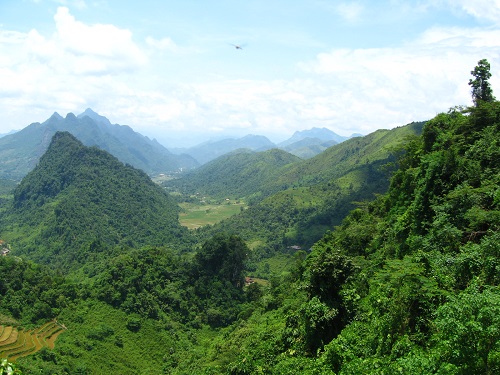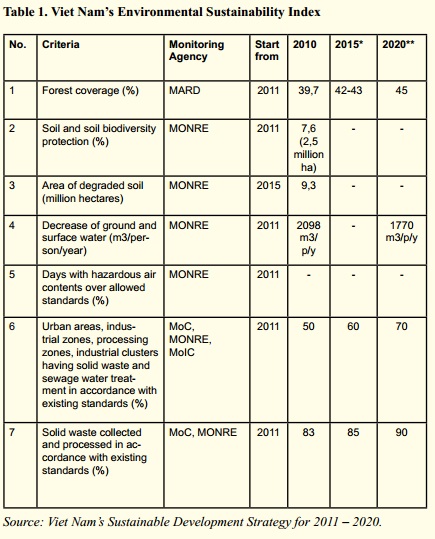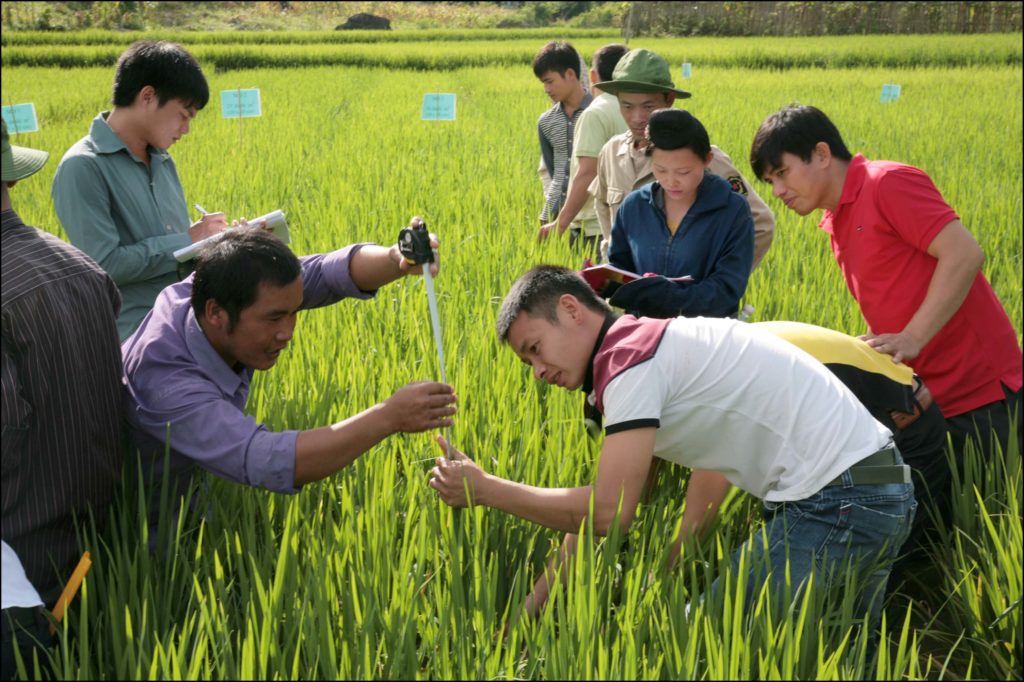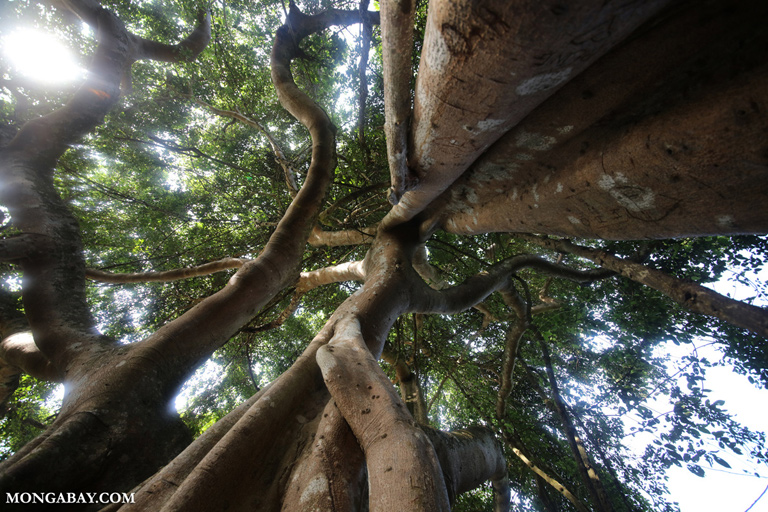Along with national programs on sustainable development and climate change response, small-scale projects with a bottom-up approach also play an essential role in implementing sustainable development goals. The paper analyzes the concepts of grassroots development and sustainable development based on a bottom-up climate change mitigation and adaptation project implemented in two Northwest provinces of Vietnam.

Viet Nam’s Forestry Sector and Environmental Sustainability
Maintaining and increasing forest coverage is identified as one aspect of ensuring sustainable development of Viet Nam in the country’s strategies. Viet Nam has seen the reversed trend in forest coverage loss since 1995 after decades of war and timber extraction for economic purposes. While there’s still controversy about quality of remaining and new forests, the statistical quantity of forest coverage looks promising.
The Vietnam’s forestry sector has been recovered since 1990s as results of afforestation and restoration of natural forests. During 1995 – 2009, the country increased its forested areas with 282,600 hectares on average, including 148,900 hectares of natural forests and 133,700 hectares of plantation (Vietnam Administration of Forestry, 2011). As end of 2010, Vietnam claims to have around 13.39 million hectares of forests, or 39.50% of forest coverage.
The regrowth of Vietnam’s forests is considered as a result of combination of economic and political responses to forest and land scarcity, economic growth, and market integration (Meyfroidt & Lambin, 2008). The new target set by the government plans to regrow 2.6 million hectares of forests by 2020, including 250,000 hectares of special-use and protection forests, one million hectares of production forests, and 1.35 million hectares of forests after harvest .
As with general perception, higher forest coverage means better natural environment. Nevertheless, to answer the question of how much forests and forestry sector actually contribute to environmental sustainability is not easy. Sustainability and sustainable development themselves do not bear clear meanings or are equipped with sets of concise measurements.
Looking at sustainability at country’s level, the current national Environmental Sustainability Index lists only seven main criteria, including two of those that can be directly attributed to forestry sector (criteria 1 and 2 in the table below).
 Environmental Sustainability in Forestry Sector
Environmental Sustainability in Forestry Sector
Sustainable forest management (SFM) is defined as the foundation for the development of the forestry sector of Viet Nam (Th? t??ng Chính ph?, 2007). Generally accepted, SFM adopts well-established sustainability concept, which aims to include social, economic, and environmental dimension into the development of the forestry sector. Environmental dimension is considered as key to determine the sustainability within SFM framework.
| Forest protection, natural protection and biodiversity conservation are aimed to effectively contribute to watershed, coastal and urban protection, natural disaster mitigation, erosion control, protection of water sources and environmental protection, and to create income sources from environmental services (environmental fees, CO2 market, ecotourism, etc.) for the national economy (Viet Nam Forestry Development Strategy for 2006 – 2020. |
During the implementation of the Viet Nam Forestry Development Strategy for 2006 – 2020 (VFDS), the Forest Sector Monitoring Information System (FOMIS) project has developed a set of monitoring indicators, including those to gauge the progress towards environmental objectives. These include: (i) number of forest fauna and flora species that are rare or endangered; (ii) rate of forest cover by elevation and slope; (iii) rate of crown cover and number of forest layers in protection forest; and (iv) area of forestland threatened by desertification. In addition, there is a separate set of indicators for forest protection, biodiversity conservation, and environmental services. This set includes eight indicators, which are (i) area of protection forests, (ii) area of special-use forests, (iii) area of forests under forest protection contracts, (iv) number of forest rangers working at commune level, (v) area of damaged forests, (vi) number of Forest Protection and Development Law violation cases, (vii) number of villages having forest protection conventions, and (viii) total values of environmental services of forests.
Assessment of VFDS implementation after four years (2006 – 2010) while recognizing the contribution of increased forest cover to the environmental protection objectives, states that the forestry sector has not brought much positive impacts for the environment. Moreover, challenges with natural forest still remain as biodiversity conservation and climate change impacts are not well addressed by existing interventions (MARD, 2010). Even the forest cover will still continue to increase in coming years, the challenges for environmental sustainability still remain when the trend of destruction of high-biodiversity primary forests and conversion of natural forests to economic land-use purposes still is not halted. Other external factors such as development of market agriculture and high population densities in marginal mountainous areas could threaten the sustainability of the forestry sector (Meyfroidt & Lambin, 2008).
Nevertheless, the question of defining environmental sustainability in forestry is recognized as difficult due to different reasons (Smith & Mayfield, 2006). One is variation in scientific concepts, whether to look at ecological and environmental indicators or inclusion of emerging political-ecologist view-points. The traditional approach often looks at sustainability as sustainable yield to answer the question how much harvest can maintain the productivity of forest ecosystems. Secondly, while the existing technical solutions can provide meaningful tools to analyze chances of forests and environment, quality of data and statistics is questionable. For examples, there has been different critics on the statistical data of forest cover in Viet Nam (Lang, 2001 cited in (Meyfroidt & Lambin, 2008)).

Measuring Environmental Sustainability of Forestry Sector
There have been many efforts to develop sustainability indicators for the forests. In a very recent study, Grainger summarizes nine criteria and indicator schemes being used in about 150 countries since 1990, with over 60 countries employing more than one scheme. However, these criteria and indicator schemes are not much useful to really describe the sustainability of forest management. The study finds only 29% of indicators in five schemes can be applied in practical monitoring (Grainger, 2012).
Another interesting approach developed by W. Maes and colleagues tries to design a framework to assess quantitatively the environmental aspects of sustainable forest management. Through a validation process, these authors design a new indicator framework that can better access the effects of forest management on forest composition, structure and functioning. The validation process, which involves expert panels, field cross-checks in forest stands, and cost calculation, helps reduce the number of indicators without losing significant information. While this study is specificly for forests in Flanders (Belgium), the authors claim that their approach can be applied to evaluate environmental aspects of forest management in other regions, provided that local target and worst indicator values are taken into account (Maes, Fontaine, Rongé, Hermy, & Muys, 2011).
Examples above demonstrate how existing systems of indicators for monitoring sustainability and environmental dimension in forestry have been evolved and improved.
Improving Environmental Sustainability Indicators
While the VFDS recognizes environmental protection and provision of environmental services as one of key outcomes of the sector, the current set of monitoring and evaluation (M&E) criteria seems not having a strong emphasis on the environmental sustainability aspects. This is partly due to the fact that environmental sustainability criteria scatters among different categories within the existing monitoring framework.
When recognizing the importance of environmental dimension in sustainable forestry in Viet Nam, there should be more focus on both actual interventions and monitoring efforts. If sustainability is the core of VFDS, it may be worth to reconsider current sets of indicators to better reflect this perspective. Building around sustainability concept, progress of forestry sector can be gauged through three main lenses: social – economic – environmental. The current monitoring framework may have overlapping areas if we look at environmental sustainability. Environmental objectives and forest protection, biodiversity conservation, and environmental services objectives can be potentially revised and combined.
Emerging dimension in forestry such as climate change and impacts; REDD , PES and other forestry-related climate change initiatives should be also included in the monitoring framework, considering the fact that they can contribute to and have impacts on environmental sustainability.
On the other hand, forestry activities can also result in negative impacts on biodiversity and the environment. In short, impacts from forestry may include biodiversity loss, illegal hunting, illegal settlements, livelihoods of forest dwellers, and climate change (Secretariat of the Convention on Biological Diversity, 2009). This should also be adequately monitored and evaluated, not only focusing on the positive aspects of forestry sector.
And if VFDS proves to have significant roles in ensuring environmental sustainability, the current criteria of Viet Nam’s Environmental Sustainability Index need to be broadened to include specific contribution from forestry sector to the national sustainable development goals.
Trinh Le Nguyen – People and Nature Reconciliation (PanNature)
The article was on FSSP Newsletter Vol.34-35 and published by The Forest Sector Support Program on July 2012.
References
Grainger, A. (2012). Forest sustainability indicator systems as procedural policy tools in global environmental governance. Global Environmental Change, 22(1), 147-160. Retrieved from http://www.sciencedirect.com/science/article/pii/S0959378011001348
MARD. (2010). Vietnam Forestry Development Strategy: Progress Report 2006 – 2010. Hanoi.
Maes, W. H., Fontaine, M., Rongé, K., Hermy, M., & Muys, B. (2011). A quantitative indicator framework for stand level evaluation and monitoring of environmentally sustainable forest management. Ecological Indicators, 11(2), 468-479. Retrieved from http://www.sciencedirect.com/science/article/pii/S1470160X1000124X
Meyfroidt, P., & Lambin, E. (2008). The causes of the reforestation in Vietnam. Land Use Policy, 25(2), 182-197. doi:10.1016/j.landusepol.2007.06.001
Ngân hàng Th? gi?i. (2011). Báo cáo phát tri?n Vi?t Nam 2011: Qu?n lý tài nguyên thiên nhiên (p. 168). Hà N?i. Retrieved from http://www-wds.worldbank.org/external/default/WDSContentServer/WDSP/IB/2012/03/28/000386194_20120328021334/Rendered/PDF/666340Vietname0phattrienVietNam2011.pdf
PanNature. (2011). Policy Review, No.3/Quarter III. Hanoi: PanNature.
Secretariat of the Convention on Biological Diversity. (2009). Sustainable Forest Management, Biodiversity and Livelihoods: A Good Practice Guide. Montreal.
Smith, T., & Mayfield, C. (2006). Environmental Sustainability and Sustainable Forest Management. Forest Encyclopedia Network. Retrieved from http://www.forestryencyclopedia.net/p/p2/p1137
Th? t??ng Chính ph?. (2007). Chi?n l??c phát tri?n lâm nghi?p Vi?t Nam giai ?o?n 2006 – 2020.
Vietnam Administration of Forestry. (2011). Vietnam Forestry: Introduction of Forests and Forest Sector of Vietnam. Hanoi.



